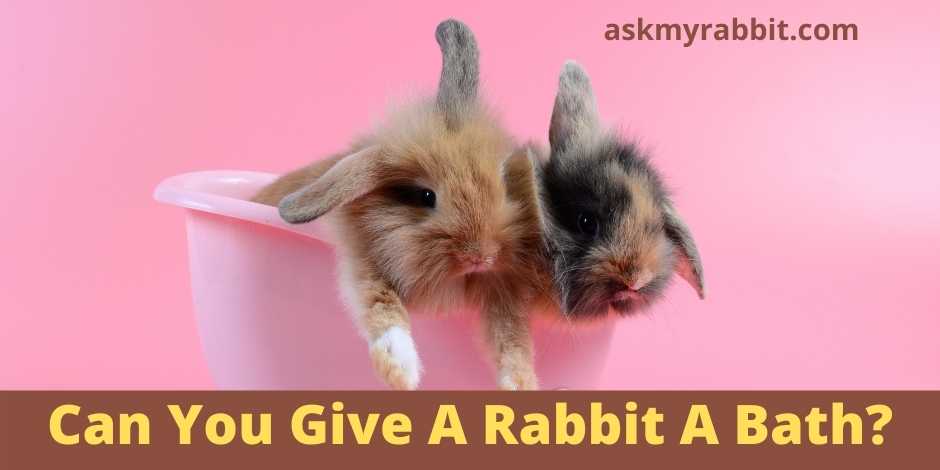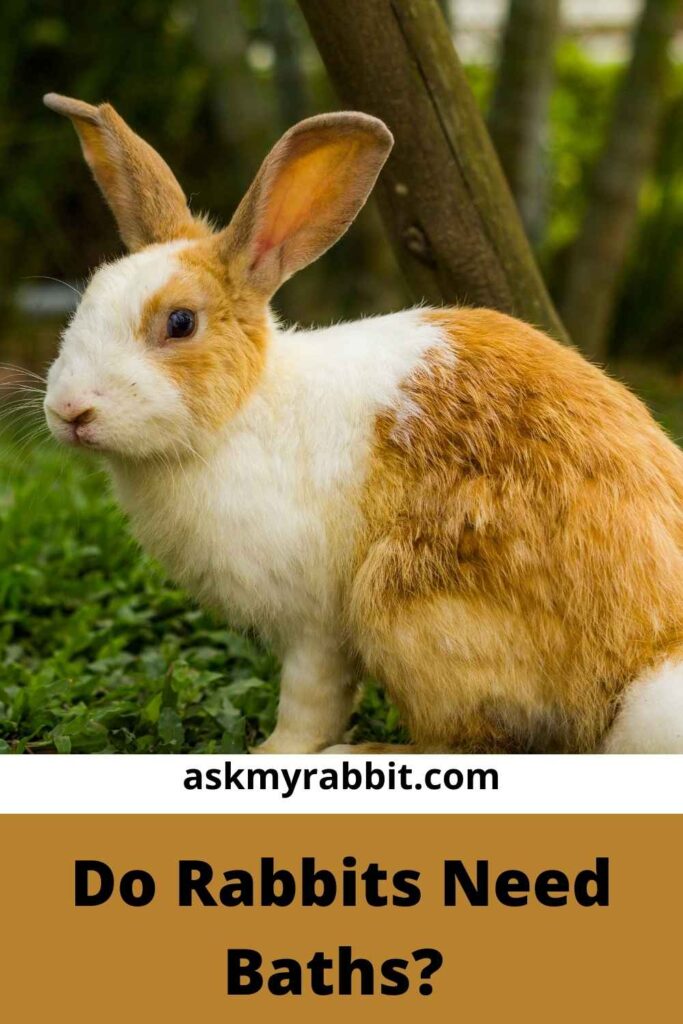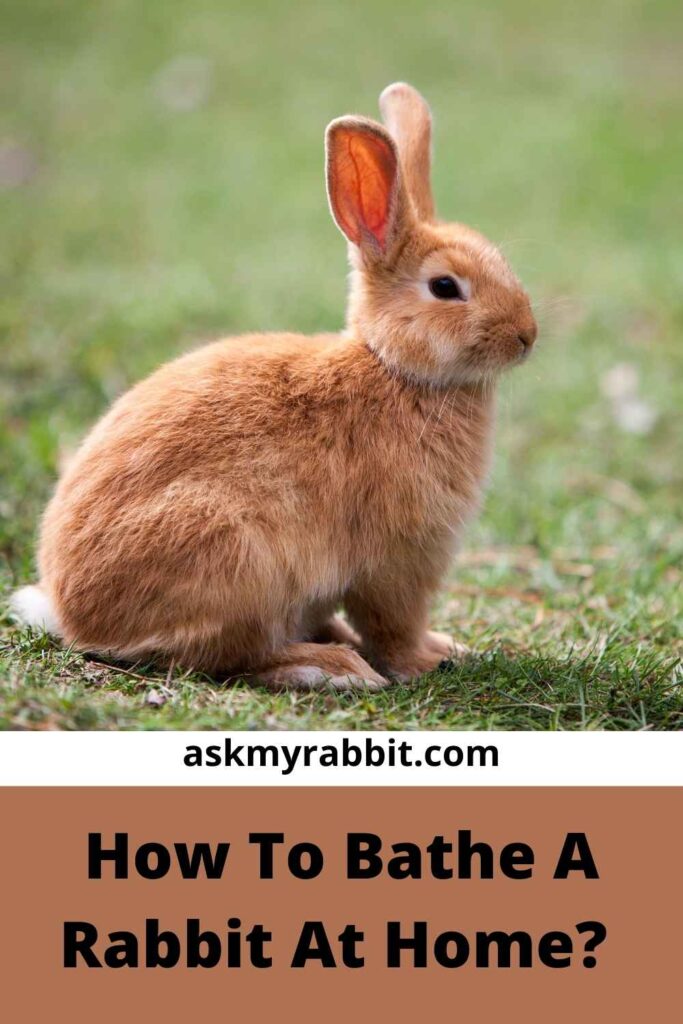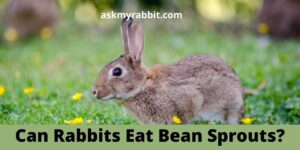Rabbits are scrupulously clean and seldom require bathing. Bathing them can be dangerous since they fear water and may thrash about in it, breaking a limb or their spine. Wet rabbits can get a cold and develop pneumonia, respiratory infections and other life-threatening illnesses.
You should not give your rabbit a bath. Rabbits, in general, avoid having their feet wet in normal circumstances. Rabbits dislike feeling exposed, and being in water isn’t a natural position for them to be in.
Rabbits also panic when they’re in water, and thrashing around in the water can easily fracture their spine or leg. Furthermore, when wet rabbit hair clumps together, it’s difficult to get them entirely dry. Rabbits who are kept damp are at risk of respiratory infections and hypothermia.
You should only wash a bunny if a competent physician who specialises in rabbit care explicitly instructs you to do so.

Do Rabbits Need Baths?

There may be times when it is important to bathe your rabbit to some extent for health reasons. It is seldom necessary to soak the entire rabbit.
Rabbits whose rear ends are often contaminated with caecotrophs and/or urine may require regular bottom washing. This is to reduce the danger of flystrike and prevent urine scalding and blisters.
These rabbits frequently have underlying medical problems implying that they do not keep themselves clean.
This is completely needless, and it may be quite damaging to rabbits. Rabbits don’t need to be bathed on a regular basis, and frequent washing, strips the rabbit’s fur of its natural oils. This helps to keep the rabbit’s coat in excellent shape.
Bathing is also quite stressful for rabbits, and it poses a number of significant risks. Rabbits are tidy creatures who groom and clean themselves. Companion rabbits will also brush and wash each other.
You will need to brush your rabbit often, particularly during a moult, to remove all of the fur they lose. However, we should not need to bathe your rabbit at this time.
Is It Okay To Bathe A Rabbit?
You should avoid bathing your rabbit as much as possible. If your veterinarian approves, you must bathe your rabbit with extreme caution.
Make sure the water is at a suitable temperature. Never submerge him completely.
Starting with his back and working forward, we suggest bathing and gently rinsing him in parts. This will guarantee that the wash is as safe and stress-free as possible.
Making this a two-person task is also a good idea. Allow one person to hold the bunny comfortably while the other cleans him. To prevent your furry companion from being chilly, do everything as fast but gently as possible. Always have a warm towel on hand.
How To Bathe A Rabbit At Home?

If your veterinarian advises that you bathe your rabbit for health reasons, enlist the assistance of another person. This is so that one person can retain a tight grip on the rabbit while the other bathes it.
This aids the rabbit’s grasp, reducing the likelihood of fear and thrashing/scrabbling. Use warm water and keep an eye on it to make sure it doesn’t get too hot or too cold.
Showers may be noisy and strong at times. Use a jug of water is usually preferable.
Begin with the rump of the rabbit and work your way forward, soaking the fur all the way to the skin. Do not wet their head unless your veterinarian instructs you to.
Avoid getting water or shampoo in their eyes or ears. If you’re using shampoo, give it a good lather and then completely rinse it off.
If you’re soaking the rabbit or washing off the shampoo, make sure to drain the dish periodically so the water level doesn’t rise. The rabbit will not enjoy sitting in too much water. Bathing them in a bath or sink where the water drains out continuously down the plug may be preferable.
If you’re simply washing the rabbit’s rear end, carefully place them in the sink. Then have your assistant pull their front end out of the water by placing one hand under their chest and the other on top.
Leave only their back end in the water, and then wash their back end. When you’re done, gently pull the rabbit out of the water and wrap it in a warm towel. Bathing should be done as soon as possible to prevent the rabbit from becoming too chilly.
How Often Should I Bathe My Rabbit?
In general, the dangers of washing a rabbit outweigh any potential advantages. Rabbits, for example, may feel threatened and panic in the water. This may result in a variety of unpleasant injuries for both you and your pet.
Furthermore, because their fur is notoriously difficult to dry, your bunny may be at risk of hypothermia or respiratory problems if kept wet or damp.
Even yet, your veterinarian may advise you to wash your rabbit in some circumstances. A spot wash would most usually enough, however your veterinarian may prescribe a prescription shampoo for extremely sensitive areas.
Always consult your veterinarian for a shampoo advice for your rabbit, since even pet shampoos aren’t always suitable for bunnies.
Why Is It Bad To Bathe A Rabbit?
Bathing rabbits in their entire bodies might be harmful or even fatal. Rabbits should be given a dry bath instead of a full-body wash.
Rather than giving your rabbit a bath, take extra precautions to prevent dirt from accumulating. Brushing your rabbit’s fur on a daily basis is one technique to achieve this.
While some rabbits like bathing in water, damp baths might put your bunnies in risk.
The following are some of the dangers that baths might bring to rabbits:
- Stress: Rabbits are susceptible to shock and heart attacks. This may result in death.
- Injury: Physical injury can occur as a result of stress and suffering. Rabbits have powerful hind leg. Any attempt to flee might destroy their delicate spine.
- Hypothermia: Rabbit hair takes a long time to dry, resulting in hypothermia. When rabbit fur is moist, it prevents heat from being trapped inside. Even in mild weather, this can cause hypothermia.
- Skin Disease: Rabbits have delicate skin and are susceptible to a variety of skin diseases.
- Ear Infections: Water entering into a rabbit’s ear can induce an ear infection since the rabbit has no method of removing the water.
How To Bathe Rabbits Safely?
Although rabbits cannot be washed, there are still ways to keep your bunny clean. The trick to cleaning your rabbit is to use as little water as possible.
In an ideal world, no water would be utilised at all. When water is required, however, it should only be used in the places where it is required.
When washing rabbit fur, keep in mind that your rabbit’s comfort comes first. If your rabbit doesn’t want to take a bath, don’t force it. This may cause harm to your rabbit as well as unnecessary stress.
If your rabbit starts to struggle in the middle of the bath, finish it quickly and let the rabbit out. If you must continue, leave some time between sessions so your bunny does not become stressed.
Cleaning rabbit hair may be done in stages, but they do not have to be completed in order. In fact, providing a buffer between baths is preferable. It would be less stressful for both you and your rabbit, as well as safer and more comfortable.
How Do I Give My Rabbit A Dry Bath?

When it comes to washing your rabbit, a dry bath should be your first choice. Water should not be used to clean rabbits in the first place.
A dry bath removes filth and grime that could otherwise be removed without the use of water, reducing the risk of damage.
Dry bathing do not upset rabbits when done correctly. Dry baths, in fact, may be a relaxing experience. It may also be a fantastic method for you and your pet rabbit to bond.
The greatest harm that dry baths may cause comes from poor handling, which shouldn’t be an issue if rabbits are used to being handled and if their owners are used to handling their bunnies.
Dry baths utilise baby corn-starch instead of water to eliminate dirt and debris. This offers a pleasant experience for your rabbit while also keeping it clean.
Baby corn starch is an excellent way to remove dirt and debris without adding moisture. Corn starch, in fact, absorbs moisture.
It is simpler to remove the solid filth and grime that has collected on your rabbit’s hair due to the lack of moisture. Corn-starch is likely to be pleasant and non-irritating because it is designed particularly for a baby’s skin.
Choose a solution that is pure and odoorless to guarantee that it will not irritate your skin. Baby corn-starch, along with other baby powders, may be bought in the baby aisle.
You’ll need the following items to give your rabbit a dry bath:
- Gloves made of rubber
- Towels
- Corn-starch
- Fine-toothed flea comb
Now follow these steps to give your rabbit a dry bath:
1. Get Bath Ready
Select a clean, flat area on which to lay your rabbit. It would be beneficial to have a clean floor. To keep your rabbit comfortable, cover the area with something soft, like a bath towel. Make sure you have your corn-starch bottle handy.
2. Put On Gloves
Make sure to put on some rubber gloves in addition to prepping the area. A clean pair of ordinary yellow home gloves would suffice. Gloves will help you keep a firm grip on your bunny.
3. Your Rabbit’s Safety
Gently yet firmly secure your bunny. To reduce the risk of strain, have someone else hold the bunny for you if feasible.
4. Toss In The Powder
Apply the powder liberally to dirty parts of your rabbit’s hair using your other hand. Then massage the powder into the fur until it reaches the skin. It’s preferable to take your time and repeat the process rather than being overly harsh and endangering the rabbit.
5. Remove Debris
Massage the powder into the clumps of dirt as you work it into the fur. Debris should readily come away if it’s encased in enough corn-starch, either slipping off the fur or breaking apart.
Use a fine-toothed flea comb if the material appears to be trapped. This comb will help you remove particles from your rabbit’s hair.
if the debris refuses to budge, don’t push it. Your rabbit’s fur may be damaged as a result of this. To check if it changes, try adding additional corn-starch. If not, ignore it and go on.
6. Loose Powder Must Be Removed
Shake off any loose powder from the places where you applied powder. Make careful to pat thoroughly yet softly.
Your bunny deserves to be rewarded. As a reward for your rabbit’s good conduct, give it a treat. Any loose powder on the floor should be vacuumed up, and the towels should be washed.
How To Bath A Rabbit With Fleas?
A flea comb will do the work if there are only a few fleas. To kill the fleas, thoroughly comb your bunny’s fur. Dunk the comb in warm soapy water or alcohol. Rinse the comb thoroughly before reapplying it to your rabbit.
In more serious situations, a rabbit-safe topical treatment such as might be used. For correct dose and administration directions, see your veterinarian.
The solution should be placed on the back of the rabbit’s neck, where it will be impossible for him to lick it away. If you have more than one rabbit, keep them apart so they don’t lick the medication off each other.
Frequently Asked Questions
Why Do Bunnies Wash Their Face?
Rabbits, like cats, are quite concerned about grooming themselves. They value feeling clean, and their faces play an important role in that.
Why Does My Bunny Sleep Next To Me?
If a rabbit approaches you and lies down on its side, it is expressing its faith in you. This is especially true when your rabbit sleeps close to you. You may be confident that your rabbit trusts and loves you if they totally flop down next to you or start nodding asleep.
Do Rabbits Like Mirrors?
Rabbits are blind to their own reflections. Your rabbit will think it’s another rabbit if she encounters a mirror.
Final Words
Because your buddy takes care of his grooming, the least you can do in return is keep his habitat clean. In reality, a rabbit’s habitat has a direct and substantial impact on his health.
Thus, keeping your pet’s area clean is necessary. Anywhere your rabbit defecates should be cleaned on a regular basis.
Your bunny will enjoy the clean environment and absence of odor, while you will like the fresh, just-washed sensation. Once you and your rabbit have established a brushing and spot cleaning regimen, your relationship with your bunny will improve.
Drop down your queries regarding your little bunny in the comment section below. We will answer them soon!






